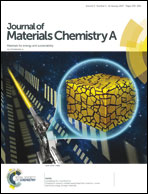Metal in situ surface functionalization of polymer-grafted-carbon nanotube composite membranes for fast efficient nanofiltration†
Abstract
The development of inorganic functionalized membranes with the capacity to effectively separate molecules or ions in solutions based on the size or electrostatic interactions is pivotal to purification and separation applications. Herein, we demonstrate a novel green strategy utilizing a completely aqueous process to construct an asymmetrically structured metal surface functionalized polymer–matrix nanocomposite nanofiltration membrane. Crosslinked polyethyleneimine (PEI) is grafted on a carboxylated carbon nanotube intermediate layer incorporated into the macroporous cellulose acetate substrate to form the composite membrane. The resulting membrane is subsequently inorganically modified via an in situ surface reaction of zinc nitrate with excess ammonium hydroxide to produce the hydrophilic and positively charged membrane. Crosslinking enhances the polymer interaction with the carbon nanotube interlayer which in turn endows it with mechanical strength and sustains the membrane pore structure during pressure driven filtration. The functionalized membrane displays outstanding pure water flux of 16.5 ± 1.3 L m−2 h−1 bar−1 while exhibiting good nanofiltration performance of bivalent cations, which is ascribed to the electrostatic repulsion via the Donnan exclusion effect. Meanwhile the membranes exhibit excellent separation of organic molecules and long-term filtration stability. This newly developed approach presents a promising route for the construction of highly permeable nanofiltration membranes for fast purification and separation applications.


 Please wait while we load your content...
Please wait while we load your content...